For almost as long as there have been films, there have been spooky stories about roving spirits, demons, or creatures flexing their supernatural muscle. This month’s release of a pair of supernatural thrillers in The Apparition and The Possession may or may not prove out this author’s recent thesis on Hollywood’s rotating wheel of cinema terror (Satan’s a-comin’!), yet it will undoubtedly demonstrate what has always been obvious: scary movies know no exclusive season.
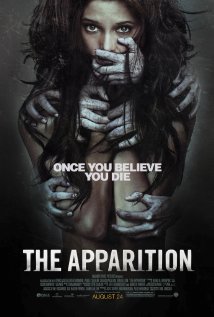 We are a few months removed from Halloween, yet the cinemas are still churning out scary horror pictures for the hungry masses, their insatiable lust one that must be dealt with year-round. Thus, just like these films know no temporal limits, neither shall a list honoring the same, and that’s precisely what scene-stealers has on its hands today.
We are a few months removed from Halloween, yet the cinemas are still churning out scary horror pictures for the hungry masses, their insatiable lust one that must be dealt with year-round. Thus, just like these films know no temporal limits, neither shall a list honoring the same, and that’s precisely what scene-stealers has on its hands today.
Today’s ranking recognized the most terrifying, unsettling, and well-orchestrated ghost-haunting examples of the last century or so, and ranked them according to how effective/awesome they were in conjunction with the picture’s overall quality. In other words, the more unsettling the haunting and specters, then all the better for the film’s position below. The list did make the distinction between proper hauntings, and demonic possessions, but this was only after a very, very heated discussion with the 10rant faithful, who take such arbitrary rankings seriously. Indeed, it was decided that possessions and curses fell under their own umbrella of categorization, so offerings like The Exorcist, Evil Dead (et al) and Nightmare on Elm Street (et al) were regrettably eliminated.
Some run-of-the-mill disqualifications included Suspiria, which was more rooted in witchcraft than supernatural haunting, House on Haunted Hill (1959), as there really wasn’t any confirmed “haunting” in that picture, just murder-mischief, as well as Paranormal Activity, which sucked WAAAAAAY too much to get a spot. A few very respectable hauntings that just missed the cut included The Amityville Horror, Sleepy Hollow, What Lies Beneath, all Japanese horror cinema (which puts this author to sleep) and Ghost (sorry, Swayze, wherever you are). So, you ready to get scared sheetless? Here’s the Top 10 Scariest Ghost Movies. If you have a Top 10 you’d like to contribute, email eric@scene-stealers.com.
A few quick words for the 1980s cult classic, one so humorously self-serious and dated that any scary sheen has long-since worn off. House told the story of “Cobb” (William Katt), a horror novelist, Vietnam vet, divorcee, and father to a vanished-without-a-trace child. The movie started in well after Cobb’s kid had gone missing, and set its events around the novelist trying to get in some work on a new book. Holed up in the mansion of his recently deceased aunt (an unfortunate suicide), Cobb tried to hammer out his next best seller, yet couldn’t quite get over the bad dreams he began having after arriving at auntie’s place. Things only got worse, however, when Cobb had to contend with strange creatures lurking in the house’s shadows, along with little goblin fuckers that made runs on his place.
All of this culminated in the discovery of an alternate dimension portal behind Cobb’s bathroom medicine cabinet, one that pulled the poor bastard in for a visit! Fortunately for Cobb, this alternate ghost dimension just so happened to be the place where his kid had run off to, so after scooping the boy up, Cobb shagged ass back to the medicine cabinet portal and freedom. Somewhat cheesy by modern standards, and with ham-fisted acting that would make a prison theater troupe look good, House was still spooky at times (sorta), and was a good time if nothing else, making it something of a predecessor to this much better ghost haunting from just a couple years later…
I was halfway through a write-up of Sleepy Hollow when the memory of Beetlejuice rocked me like a thunderbolt. Somehow I had forgotten this one when reviewing the catalog of possible candidates, and am glad for the sudden realization which brought it to my psyche’s attention. Still one of Burton’s finest and most enjoyable efforts after all these years, Beetlejuice was slamming. Shit, just look at the cast! Alec Baldwin, Geena Davis, Winona Ryder, and a foaming-at-the-mouth Michael Keaton let right the hell off the leash. Adam (Baldwin) and Barbara (Davis) were living the idyllic east coast life when a stray dog and a header off a bridge sent the couple into the next dimension. Decidedly expired, though stuck in a 125-year holding pattern until their deaths could be processed, Barb and Adam took to haunting the new inhabitants of their home to pass the time.
Unable to dislodge the yuppie artist clan from their country estate, Adam and Barbara turned to a “bio-exorcist,” one “Betelgeuse” (Keaton), to drive out the living. A true professional, the B-Man didn’t dick around with pedestrian spook tactics, or even unsettling spiritual ambushes, no. This guy went to fucking war. Inspired by a new-found lust to re-enter the physical world via a shotgun marriage, Betelgeuse ran with his new assignment, and took things considerably further than Adam and Barbara had expected. By the end of the film, the entire goddamned house was coming alive to subdue its occupants and get them ready for the great sand-worm feast of 1988. Once the fabric in space-time tore a little, Adam and Barbara’s house became the center of the ludicrous universe: sporting everything from mutant chairs to ordained troll ministers. A ripping good time, Beetlejuice fell into similar territory as that trod a decade later by…
You might have missed this one when it first came out, and that’s a shame, for the director has made quite a name for himself in the interim. Yes, before Peter Jackson went to Middle Earth with Frodo, Gandalf, and Aragorn, he went ghost hunting through middle-America (allegedly…in actuality, The Frighteners was filmed in New Zealand). The film revolved around Frank Bannister (Michael J. Fox), a former architect that had lost his wife in a car accident five or six years ago, and had developed an ability to see and communicate with the dead. Frank used this ability to set up a nice little racket whereby he’d send his ghostly friends to some poor schmuck’s house, then exorcise the spirits for a modest fee. Though this lowly existence was paying the bills, it certainly wasn’t making him any friends in a town that largely saw him as a conman. Yet once a murderous force very similar in appearance to the Grim Reaper started marking townsfolk with indicators of death that only Frank could see, shit started popping off, and the race was on to save some lives.
Released just a couple of weeks after Independence Day in July of ’96, The Frighteners never really had a chance. In the mid-90’s, summer audiences were still lapping up the f/x-driven explosion montages that have made men like Jerry Bruckheimer wealthier than most small nations. Initially slated for a Halloween opening that year, the studio decided to bump the release date up, thus sealing the picture’s fate. Though The Frighteners was knee-deep in special effects, the quirky, off-kilter tone and multi-dimensional characters (pun TOTALLY intended) were a refreshing change of pace for an industry that was giving audiences a full-court action press at the time, character development be damned. The film presented ghosts that were both good and bad, and had some fun with the genre’s expectations and cinematic history. A student of film, and an admitted movie-dork, one could tell that The Frighteners was a labor of love for Jackson, who obviously crafted his picture to honor such haunting-horror staples that made pictures like this one possible
Caught up in the swirling whirlwind of Hollywood gossip and industry scuttlebutt, rumors of a third Ghostbusters film have been floating around aimlessly for years like that dead creature your pool skimmer can’t quite reach. Though Dan Aykroyd has lobbied hard for a third installment, the earth-shattering shit-tsunami that fell upon the world in the wake of Ghostbusters II has kept the franchise in a limbo. This suspended state is not unlike the Containment Unit the boys used to house the captured ghosts in the films, for something is certainly in there, yet nobody’s sure just what to do with it. The first movie was decent enough, though. The fresh, rapid-fire chemistry between Harold Ramis and Bill Murray had led to the minting of such comedy classics as Caddyshack and Stripes, and was only further augmented by the presence of SNL alum Aykroyd, whose unique comedic flavor was just enough spice for the comedic jumbo.
The result was a light, though always-interesting journey through a familiar New York landscape, led by familiar guides, into thematic territories involving ghosts and monsters. With a different cast and director (Ivan Reitman helmed this one, remember), this might have devolved into a goofy, uninspired B-movie, yet Ghostbusters achieved the perfect balance between scary and non-threatening. Because the picture rooted its characters and plot in a real-world setting (New York) with their leads playing familiar character sketches, the fantastic became plausible, and a world where ghosts suddenly started appearing in very public areas felt like a comfortable reality. Probably the most fun and funny horror film until Shaun of the Dead came out twenty years later, Ghostbusters was indeed outstanding, and a decent scare. Hey, speaking of Bill Murray…
Often overlooked when discussing Mr. Murray’s best work, Scrooged was a film that put its lead actor in the best possible position to succeed. Frank Cross was a man right out of Murray’s best playbook: a villainous corporate heel so jaded and unapologetically callous that one couldn’t help but to love the guy a little. Of course, everyone had seen a version of this character before, as Scrooged was a 20th century re-telling of Dickens’ ‘A Christmas Carol,’ one Murray’s character was actually producing for a television movie within the picture. The kicker came when Frank Cross came to face to face with his old boss, who told his old protégé that a few ghosts would be visiting before long. The picture played out via the familiar vignettes cinema and literature fans know all-too well by now, though Murray’s acerbic sarcasm and arrogance certainly spiced the old tale up a bit as hard truths from the past and present confronted Frank.
As funny as Scrooged was throughout most of its run, the movie still flipped the switch on occasion, and shook Frank (along with the audience) right the hell up from time to time. The aforementioned scene with Frank and his old boss was no picnic, though it paled in comparison to the work the ghost of Christmas Future put in when that gangly, dead-behind-the-eyes son of a bitch finally came along. It stood at a tick under seven feet tall from the looks of it, and was clad in classic black robes: its composition primary tortured-soul-based. Any of the cinematic interpretations of the Dickens classic could have slid into the #6 slot of this list, for all told a chilling tale about a man confronted with the putrid spoils of a life selfishly lived. Yet Scrooged took things up a notch, and actually put its lead in a coffin about to get fed into a crematory incinerator! This scene, and Murray’s frantic wailing and thrashing inside a burning coffin, was enough to give me nightmares for years, and was one hell of a way to bring the Ghost of Christmas Future’s message home. For that, it got #6, ahead of this next film, which really should have had that honor…
M. Night Shyamalan’s only tolerable film to date, The Sixth Sense is one creepy goddamned movie. I don’t care what anybody else says, this one had me going right up to the end, and I know I wasn’t the only one. A film pertaining to haunting in general, not just in a particular place, this film wove a delicate narrative about a terrified young boy with a peculiar gift whilst exploring what it meant to be dead without any concept of what that entailed. When it hit the road in 1999, the film blew damn near everybody who saw it right out of the theaters, and started a word-of-mouth craze that’s the kind of thing Hollywood executives jack off to. As the lead (Haley Joel Osment’s Cole) wandered through the terrifying spectral wasteland that was his nightmarish life, Shyamalan created a very textured, deliberate canvas for his film. The director’s careful use of colors and music cues kept the audience on the edge of their collective seats, yet leaning in all the same.
The scenes that involved reanimated spirits were nothing short of terrifying, even the mundane examples like the young head-shot wound victim bone-chillingly effective. Once the picture ratcheted up the intensity and went headfirst into the nasty, puking ghouls, suicidal housewives, and hanged criminals started bouncing off the walls. Recalling younger days when I didn’t even like going into a dark room in the middle of the day, my primal instincts kicked in immediately when first viewing this picture, for as skittish as I was as a child, I didn’t have half the problems of some poor little bastard seeing ghosts! The Sixth Sense got tons of mileage out of Cole’s entirely understandable disposition in this film, which was essentially scared shitless 23 hours out of 24 in a given day. Unable to take a leak without some nosy ghoul barging into his personal business, Cole lived a life nobody would envy, especially considering the dual burden of seeing the dead, and helping them through the realization that they are no longer living. Speaking of which…
Woo! I actually sat down to watch this one after fielding ideas from the 10rant gallery for this list’s possible candidates, and this was definitely a worthy member of today’s field. The Others followed the experiences of a mother (Nicole Kidman’s Grace) in the immediate aftermath of WWII, and that woman’s attempts to create a stable, low-impact household for her two children. The trio moved into a remote estate in the British countryside, and at first seemed to enjoy the company of the elderly gardener and nanny attached to the estate. Grace started getting the creeps when spooky doings started popping off, however, and was quick to investigate the disturbances, shotgun in hand. Though the kids were immediately convinced that ghosts were the culprits, Grace was slower to come around. Events began to force her hand, however, for pianos were heard to play in rooms known to be empty, and doors suddenly came unlocked that had been securely fastened.
Shit really hit the fan when Grace’s husband, thought to have been K.I.A. in the war, mysteriously returned out of a night’s fog, an event followed by the sudden transformation (at least in Grace’s eyes) of her daughter into a stranger (then back again). The whirling plot elements finally came to rest when Grace realized that her servants, her husband, her children, and even she were actually all dead and living together in some kind of spiritual utopia where the deceased all mingle together and socialize as if attending a shitty cocktail party. The visions Grace had seen were the living inhabitants of the house, and she, along with her family and the help, were the ghosts. In fact, Grace had smothered her children in a sudden psychotic rage, then killed herself in a desperate act of contrition not long before the film began. Her fate, along with her family’s, was to roam the halls of the estate for as long as the powers controlling such things deemed appropriate, a truly spooky note with which to leave a movie that was already creepy as fuck.
One rule which every devoted horror aficionado should observe and appreciate follows thus: never build anything on top of a cemetery. To be fair, the Freeling family didn’t realize their house sat atop a burial plot until the movie was well into its run, and made every effort to kick some ghost ass once they got a handle on what they were dealing with. But the situation wasn’t good. At one point, some kind of possessed tree reached through one of the kids’ windows to take the boy back into the earth, something that turned out to be a distraction so that the television could lure the family’s little girl into some demonic portal housed in the bedroom closet! No shit! The possessed house went ahead and just kidnapped the girl into another dimension. Now THAT’S some haunting, son! Say what you will about some of these other choices, once the ghosts start snatching little kids up and running them off into alternate universes, shit gets real.
When this was released in 1982, Poltergeist knocked the socks off audiences. Produced (and according to which rumor you believe, co-directed) by Steven Spielberg himself, the film acted as the darker counter-punch to the wildly successful E.T., also released that year. Though both films dealt with average suburban families in extraordinary situations, one took a whimsical approach that emphasized friendship and trust whilst the other grounded its message in the blackest, darkest, most inescapable evils of this world. Plagued by a supposed curse that actually came after the principals of this film, Poltergeist achieved immediate infamy both because of what it did on the screen, and to the collective psyches of those sitting before it. A top-notch production that painted a terrifying picture while still retaining the human elements of its leads, Poltergeist missed out on the #2 spot because it just wasn’t as classy as…
Jesus, talk about a cinematic pedigree! This movie could brag about Truman Capote penning its script, not to mention Martin fucking Scorcese calling it out as one of his favorite horror films of all time. A break from the boorish scare-a-minute industry flicks and the radioactive creature features of the era, The Innocents presented a more thoughtful offering to the genre. Built on a foundation rooted in psychological manipulation through a combination of lighting effects, character development, and subliminal imagery, this film frightened its audience without soaking them in blood (sorry, Evil Dead). It tracked the experiences of a young nanny, Miss Giddens (Deborah Kerr), who was hired at the beginning of the film to oversee the wealthy niece and nephew of some foppish English Lord. Though things seemed to be going well enough at first, once the nephew returned from boarding school, freshly expelled, things hit the fan.
It turned out that Miss Giddens was the replacement for the previous governess, one Miss Jessel, who killed herself following the death of her not-so-secret lover, the former valet. Miss Giddens started becoming suspicious of the behavior of the children, who seemed to act not at all like a pre-teen brother and sister, but instead like the possessed receptacles of two children controlled by ghosts. Indeed, the niece and nephew had been mostly taken over by the spirits of Miss Jessel and her valet lover, and were consequently getting into all sorts of trouble. At one point, the nephew tried to get all-sorts of familiar with a shocked Miss Giddens, who nearly got molested by a boy maybe a third her age! A movie now fifty years old, I still don’t want to ruin the ending of this one, for though the picture is well-beyond acceptable SPOILER territory, some surprises should never be ruined.
Good heavens: Kubrick and King. Like the meeting of Anthony and Cleopatra, the wild fury that overtook the universe when the giants of two different empires collided still reverberates. Penned in 1977, ‘The Shining’ immediately struck a cord with readers, and catapulted the mildly famous Stephen King into literary super-stardom. An insanely creepy novel, at the time it must have seemed only fitting that Stanley Kubrick take the reins of the cinematic adaptation. After all, the man had recently knocked out 2001, A Clockwork Orange, and Dr. Strangelove, so if anybody possessed the moves to get inside King’s masterpiece, it was Kubrick. The director did something wild, however: he all but abandoned the book’s narrative. Though the essential framework of what King had created was still there, radical departures from the source material became commonplace. And why the hell not, huh? Kubrick wasn’t about to let some Yankee scribe with a drinking problem out-scare his audience! Stanley unapologetically altered serious plot points both to please his sense of pacing and plot, but also to keep a well-read audience constantly on its toes, the result of which was a horror masterpiece still regarded as one of the finest in its field.
Kubrick had to have known he was dealing with movie-goers who thought they knew what was about to happen, thus he screwed around with all kinds of shit so that the film became a shadow of what King had constructed. Whatever the motivation, the creative marriage forged between these two men came together and assembled into one of the greatest films, horror genre or otherwise, ever made. The audience watched as the malicious and murderous spirit of the Overlook Hotel permeated every crevice of the set, as the long-dead spirits seeped into the psyche of the frail and impressionable Jack. Slowly but surely the hotel began to win out, and the mild-mannered husband and father gradually transformed into a homicidal agent of doom; blood-filled elevators, naked hags, and demon twins aside, the murderous elements of this haunting made the example an especially notable one. Scarier than hell with a haunting that had a hard-on for violence, The Shining stands alone atop the spooky mountain.




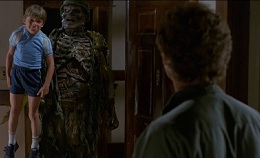
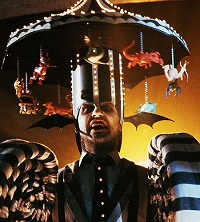
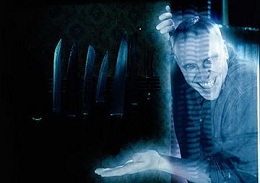
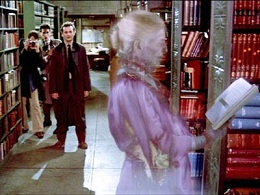
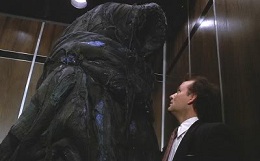
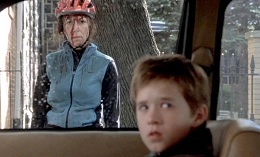
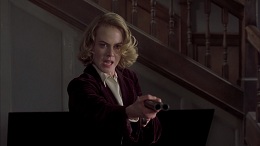
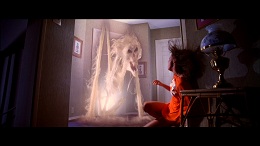
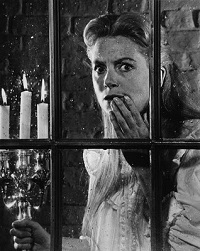
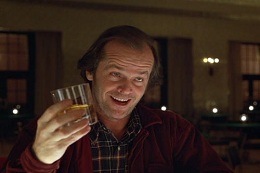

{ 2 comments }
I think all of the Top 5 here would make my list, but I’m thinking of a different “House” (#2 on this list), and also the excellent Japanese ghost story “Kuroneko”!
Nice to see Frighteners in this listing. A very unique film that is hard to put your finger on.
I think that one of the reasons this movie never got credit was because it had its audience seriously confused between truly scary/suspenseful/disturbing moments mixed with lots of silly/comedic elements. Films like Beetlejuice or the Evil dead franchise (which are never truly scary and fall under a more tongue-and-cheek dark comedy with a bit of gore) are permissible because they lean clearly on one side of the fence. But films that marry a very serious primal fear based psychological-horror and zany comedy are difficult to categorize.
Poltergeist is a great film and has some fun-loving mild comedic moments, but over-all would be classified as a suspense, dark mystery and haunted adventure.
Perhaps a good top 10 would be scary movies that employ humor or vice versa….
-Out
Comments on this entry are closed.